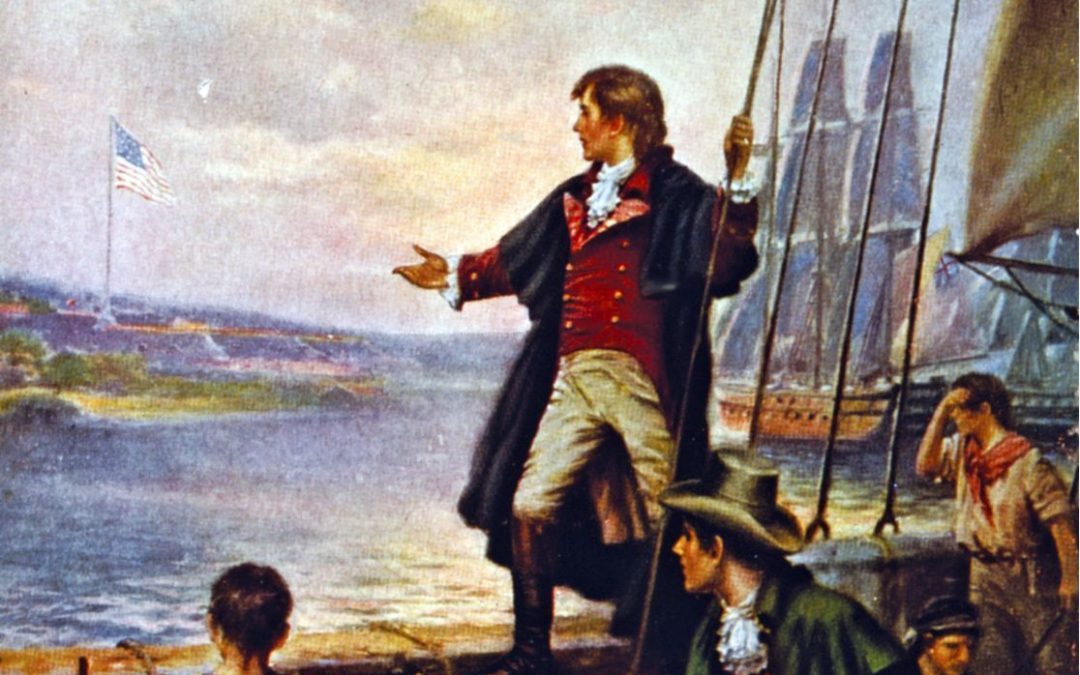By Chris Lowe
Trish O’Donnell Director of Education at the Richard Nixon Foundation
For a few moments every February, as the Super Bowl begins, Americans stand together—hand over heart—as the national anthem plays and U.S. Air Force jets soar overhead. In that moment, we set aside the issues of the day, political divisions fade, and we unite in a shared reverence for the principles that define our democracy.
“Oh, say can you see…” We’ve sung these words countless times, yet few of us truly know the story behind them—the powerful history that led to the creation of “The Star-Spangled Banner” and what it represents. To understand our national anthem, we must first explore the War of 1812 and the personal story of Francis Scott Key, Dr. William Beanes, and John Skinner.
The War That Gave Us Our Anthem
The War of 1812 remains one of the least understood conflicts in American history, despite its critical impact. Nearly three decades after the American Revolution, tensions between the United States and Great Britain were at a breaking point. The British Navy had been seizing American sailors and forcing them into service, a practice known as impressment. Meanwhile, British merchants, upset over U.S. expansion into Canada and its treatment of Native Americans, sought to curb the young nation’s growth.
On June 1, 1812, President James Madison asked Congress to declare war on Britain for the second time in American history. The war was fiercely contested on land and sea, with battles raging across the Great Lakes, the Atlantic, and major U.S. ports.
Then, on August 24, 1814, the war reached a turning point. A British force led by Major General Robert Ross invaded Washington, D.C., setting fire to the White House, the U.S. Capitol, and the Navy Yard. The British occupied the city for 26 hours before retreating to their ships.
The Arrest of Dr. Beanes
Dr. William Beanes, a well-respected physician, had been helping the wounded—both American and British—after the fires devastated Washington. However, when a British general learned of his aid, he ordered Beanes’ arrest, and the doctor was taken aboard a British command ship.
Hearing of his friend’s capture, Francis Scott Key, a lawyer and close confidant of Beanes, sought President Madison’s permission to negotiate his release. Madison agreed, and Key joined U.S. prisoner exchange agent John Skinner in Baltimore. Together, they sailed to the British flagship, HMS Tonnant, where Dr. Beanes was being held.
A Fateful Encounter
On September 7, 1814—just 13 days after Washington had burned—Key and Skinner met with Admiral Alexander Cochrane and other British officers. At first, their pleas were dismissed, but during a meal with the British leadership, Key and Skinner presented letters from wounded British soldiers who had been treated by Dr. Beanes. Moved by these accounts, the British agreed to release Beanes.
However, by then, Key, Skinner, and Beanes had overheard British plans to attack Fort McHenry in Baltimore. Fearing they would alert American forces, the British placed them under guard on a small vessel until the battle was over.
The Battle That Inspired a Nation
On the night of September 13, 1814, the British launched a relentless bombardment of Fort McHenry. Sixteen British warships fired continuously in an attempt to destroy the fort and seize Baltimore. Rain poured as the sky lit up with explosions.
From their position, Key, Skinner, and Beanes had a clear view of the battle. Through the darkness and the smoke, they anxiously watched, waiting to see if the American flag would remain flying over the fort.
When dawn broke, the sight before them was breathtaking: the American flag still waved proudly over Fort McHenry. The fort had held, and Baltimore remained in American hands. Overcome with emotion, Francis Scott Key pulled out an envelope and began writing the first lines of what would become “The Star-Spangled Banner.”
From Poem to National Anthem
Key shared his poem with his brother-in-law, Judge Joseph H. Nicholson, who had fought in the defense of Fort McHenry. Judge Nicholson printed handbills of the poem and submitted it to the Baltimore Patriot newspaper, which published it soon after.
The poem quickly gained popularity, spreading across newspapers nationwide. It was soon set to the tune of a British drinking song, “To Anacreon in Heaven,” a melody that made it easier to sing.
During the Civil War, “The Star-Spangled Banner” became an unofficial anthem, strengthening national unity. In 1889, the U.S. Navy adopted it for flag ceremonies. In 1916, President Woodrow Wilson declared it the official anthem of the armed forces.
Finally, on March 3, 1931, President Herbert Hoover signed a congressional act making The Star-Spangled Banner the national anthem of the United States.
A Legacy of Unity
Today, when we stand and sing those familiar words, we honor not only the resilience of Fort McHenry but also the enduring spirit of the American people. Through war and hardship, through division and struggle, our flag—and the ideals it represents—continues to stand strong.
So, the next time you place your hand over your heart and sing, remember the stormy night when an anxious lawyer, held aboard a British ship, watched a battle unfold and saw, at dawn, the proof that America would endure.
And he wrote:
“O say can you see, by the dawn’s early light,
What so proudly we hailed at the twilight’s last gleaming…”
—–
Chris Lowe is the Trish O’Donnell Director of Education at the Richard Nixon Foundation.

